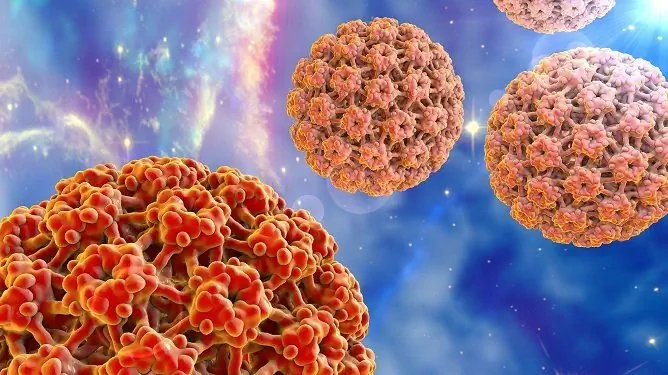- Author Rachel Wainwright [email protected].
- Public 2024-01-15 19:51.
- Last modified 2025-11-02 20:14.
Human papillomavirus in men
The content of the article:
- How is it transmitted
- Symptoms and external manifestations
- Treatment
- Video
The human papillomavirus in men manifests itself as a typical clinical picture of benign formations in any part of the body. There is no clear data on the number of infected people, since there are no regular preventive examinations in the field of andrology.
Features of pathology in this group of people:
- In most cases, when infected with papillomavirus (human papillomavirus, HPV), the development of the disease in the male body does not occur. The infection proceeds in a latent form (carrier), since it is suppressed by the immune system.
- The main route of transmission is sexual, with appropriate clinical manifestations. For this reason, the disease begins to appear and spread from the age of 16-17, that is, the time of the onset of sexual activity.
- The main diagnostic method is PCR.
- The strains responsible for the appearance of anal and genital warts are more often diagnosed (6, 11, 42-44, 54).
- Neoplasms have a carcinogenic risk and often degenerate into malignant skin diseases (basal cell or squamous cell carcinoma). The 16 and 18 strains of the virus are of particular importance.
- In a typical benign course, there is a slow progression and independent regression of foci (undulating course).
- If foci are found in any areas of the skin, a doctor's consultation (dermatovenerologist and / or oncologist) is indicated in order to determine the tactics of treatment and exclude dangerous skin formations.

Human papillomavirus is very common in both men and women
How is it transmitted
Infection with papillomavirus in men occurs in several ways.
| Way | Implementation |
| Contact and household |
1. Common household items. Of particular importance in this case are things that are in direct contact with blood (razor, toothbrush). 2. Through microcracks, wounds, abrasions on the skin when visiting public places (swimming pool, gym). 3. Self-infection during scratching and trauma to formations. |
| Sexual |
The gates of infection are microcracks in the skin that occur during intercourse. Contributing factors: · Frequent change of sexual partners. · Non-use of barrier contraception; · Earlier onset of sexual activity. |
To implement any of the transmission routes, in addition to damage to the skin (the entrance gate of infection), a disruption of the immune system is required. The virus itself is rather weak and, with a proper cellular and humoral immune response, even while in the body, does not cause clinical manifestations of the disease.
Symptoms and external manifestations
The appearance of various types of formations that are found in men on different parts of the body can vary over a fairly wide range.
| Localization | Type and characteristics of education |
| On the body |
Vulgar warts. They can be located on any part of the body, often on the skin of the hands and feet. As a rule, these are multiple formations protruding above the surface of the skin, up to 0.5 cm in diameter, painless. The color does not differ from the surrounding tissue. Palmar-plantar warts. They arise on the palms and feet and are represented by papules, plaques of various sizes. May be somewhat painful with pressure. The color is more intense due to frequent trauma. Flat warts. Formations at the same level with the skin, are located on the hands, forearms, trunk. Diameter up to 0.3 cm. Color is variable (sometimes in intensity it resembles a typical nevus). Filiform warts (see photo). Small (up to 0.3 cm in diameter), have a thin stem and hang over the surface of the skin. Localized more often in the armpits, neck and groin. Easily injured. Darker in color than the surrounding tissue. |
| In the anogenital zone |
Warty type. Wide base, up to 1 cm in diameter. Tends to merge. Localized on the body and head of the penis. Hyperplastic type. A cauliflower-like growth. The color is variable. They are single and multiple. Localized on the inner layer of the foreskin (cause discomfort during urination and intercourse). Seated (legless) type. Precancerous form. It is pigmented and slightly protrudes above the surrounding tissues. Genital warts. Occur in 80% of cases. They are located on a thin stem and hang over the skin. Color may vary. As a rule, they are multiple, with different diameters (from 3 mm to 1-2 cm). Located on the shaft of the penis, the head of the penis, the coronal groove, the foreskin, and also in the perineum. They are extremely easily injured. |
| On mucous membranes |
Pointed formations. They are located on the mucous membranes of the oral cavity, tongue, rarely along the urethra. Significantly protrude above the surface of the skin (similar to filamentous warts and anagenital warts). The color does not differ from the surrounding tissues. The diameter is different. Flat education. Akin to typical flat warts (the only difference is in localization). Diameter up to 2 cm. In case of keratinization, they have a whitish hue, usually they are painted in an intense pink-red color. Sharply delimited from the surrounding tissues. |
The symptoms of HPV in men do not differ from those in women, with the exception of genital warts, which have their own specifics.

The main symptom of HPV infection is the appearance of skin lesions, warts, papillomas, or genital warts
Common manifestations:
- In 70-80% it is asymptomatic, in 15-20% the disease becomes subclinical (recurrent formations in various parts of the body, depending on the specific strain). And only 10% (as a rule, people with reduced immunity) develop typical external symptoms of the disease.
- Severe discomfort, itching, burning sensation occur only if the focus is injured. This is especially often the case when localized in the area of the folds of the body or in the perineum and on the genitals (due to constant irritation during urination).
- Ulceration and its accompanying signs (bleeding, purulent or serous discharge, local inflammation, pain) are one of the first signs of a possible degeneration into a malignant tumor.
In most cases, in addition to aesthetic imperfection, growths do not interfere with normal life in any way.
Treatment
With timely treatment, the disease passes without serious consequences for the general condition of the person.
Treatment is based on an integrated approach and is based on three components:
- The use of topical preparations that allow you to remove the formation from the skin at home.
- Destructive therapy based on the removal of formations using physical or chemical exposure.
- Systemic therapy, which is based on strengthening the immune system and reducing the number of viral particles. In this case, we are talking about antiviral agents and immunomodulators, but these drugs are prescribed only in the case of generalized lesions. This group also includes various strengthening vitamin complexes.
Some of the most popular topical therapies are:
| A drug | Application |
| Viferon | The ointment is applied directly to the formation, slows down the replication of the virus in the tissues (neutralizes the viral pool in the basal layer of the skin). It is smeared pointwise 2-3 times a day. Practically has no contraindications and does not cause adverse reactions from the surrounding skin. |
| Supercleaner | It is a mixture of concentrated acids and has a cauterizing effect. It is applied with extreme caution directly to the focus. For formations with a small diameter, a single application is sufficient, and in the case of large build-ups, 2-4 applications may be necessary. An indicator of the correct use of the product is a change in the color of the hearth (turns white). |
| Cryopharma | An agent that acts with low temperatures on the focus with the formation of a chemical burn, which subsequently heals by primary intention. The preprarate is based on liquid nitrogen. As a rule, a single use is sufficient. |

Viferon ointment - one of the topical drugs for the treatment of papillomas caused by HPV
Destructive methods include:
- Laser therapy. Allows you to cure formations in various parts of the body, including mucous membranes. Allows to excise the formation without affecting the surrounding tissues. The excrescence is removed under the root with overhanging forms or the formations with a wide base are excised layer by layer. The procedure is performed under local anesthesia. If the lesion is extensive, several sessions may be required. The likelihood of relapse is low.
- Cryodestruction. Treatment is based on the removal of the lesion with liquid nitrogen. It is done with a special applicator. The exposure time depends on the specific variant of the formation and its location (on average, the exposure lasts 20-50 seconds). Due to the rather high risk of damage to healthy tissues, it is rarely used on mucous membranes. After removal, dressings will be required until the burn surface is completely healed.
- Electrocoagulation. The technique is associated with burning out foci using an electric knife. It is used in areas with good blood supply or if hemorrhage is suspected for additional hemostasis. When removed, healthy tissues are also affected, and therefore they are used with caution in case of growths on mucous membranes. It is performed under local anesthesia.
- Radiosurgery. The method is associated with local heating of the tissues of the focus due to the action of radio waves. It is permissible to use for processing a large field with multiple formations. The method is highly accurate and has minimal effect on the surrounding tissue.
- Classical surgery (excision with a scalpel) is used relatively rarely due to the high trauma and the impossibility of simultaneously removing several formations at once. In addition, even with cosmetic sutures, there is a risk of an aesthetically unsatisfactory result.
Video
We offer for viewing a video on the topic of the article.

Anna Kozlova Medical journalist About the author
Education: Rostov State Medical University, specialty "General Medicine".
Found a mistake in the text? Select it and press Ctrl + Enter.






